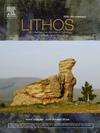The origin of EMI component in the Shikoku back-arc spreading center, Philippine Sea Plate
IF 2.9
2区 地球科学
Q2 GEOCHEMISTRY & GEOPHYSICS
引用次数: 0
Abstract
The Mesozoic-Cenozoic geological evolution of the East Asian continental margin and a series of Cenozoic back-arc basins (South China Sea, West Philippine Sea, Sea of Japan and Shikoku Basin) developing in the West Pacific region have been predominately resulted from the westward subduction of Pacific plate, accompanying with the effects of some intraplate processes. However, how the intraplate processes work remains unclear. Here we present new geochemical and Sr-Nd-Pb-Hf isotope data for the lava samples collected from Deep Sea Drilling Project Expeditions 6, 58, and 59 in the Shikoku Basin (SKB) and its adjacent region. High Nb/La ratio and enriched Sr-Nd-Pb-Hf isotopic compositions indicate that the spreading-related lavas in the SKB were affected by the enriched mantle type I (EMI) component, which can be solely produced by mixing enriched mantle components and ambient mantle. We suggested that EMI components in the asthenosphere mantle beneath the region from northeast China to Sea of Japan may be involved in the back-arc spreading processes by means of asthenospheric toroidal flow around the subducting Philippine Sea slab, or the EMI components have preexisted in the asthenospheric mantle beneath the SKB prior to the northward migration of the Philippine Sea Plate since Equator.

菲律宾海板块四国弧后扩张中心EMI分量的来源
然而,板内过程如何起作用仍不清楚。本文介绍了深海钻探项目第6、58和59号远征队在国盆地及其邻近地区采集的熔岩样品的新的地球化学和Sr-Nd-Pb-Hf同位素数据。高Nb/La比值和富集的Sr-Nd-Pb-Hf同位素组成表明,SKB扩张相关熔岩受富集地幔I型(EMI)成分的影响,这种成分只能由富集地幔成分与环境地幔混合产生。我们认为,中国东北至日本海地区软流圈地幔中的电磁干扰分量可能参与了菲律宾海板块俯冲后的弧后扩张过程,或者在菲律宾海板块自赤道向北迁移之前,南海软流圈地幔中的电磁干扰分量就已经存在。
本文章由计算机程序翻译,如有差异,请以英文原文为准。
求助全文
约1分钟内获得全文
求助全文
来源期刊

Lithos
地学-地球化学与地球物理
CiteScore
6.80
自引率
11.40%
发文量
286
审稿时长
3.5 months
期刊介绍:
Lithos publishes original research papers on the petrology, geochemistry and petrogenesis of igneous and metamorphic rocks. Papers on mineralogy/mineral physics related to petrology and petrogenetic problems are also welcomed.
 求助内容:
求助内容: 应助结果提醒方式:
应助结果提醒方式:


